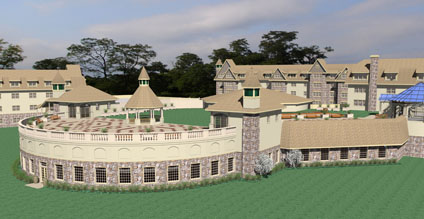Welcome to Mary's AE Senior Thesis e-Portfolio
Building Statistics
General Building Data
- Building name: Whiteland Village
- Location and site: at the Route 30/Business 30 split, Exton, PA
- Building Occupant Name: Whiteland Village
- Occupancy or function type: Retirement village
- Size: 1,320,000 sq. ft. of residence buildings
- Number of stories above grade/total levels: 5/6
- Primary Project Team:
- Owners:
- Whiteland Village
- Roskamp Management Co., LLC
- Construction Manager:
- Architects:
- Dever Architects (Residential)
- HLM Design (Commons/Healthcare)
- Engineers:
- Baker, Ingram & Associates (Structural)
- Heuser Design (Site)
- Edward B. Walsh (Civil)
- CVM Industries (Geotech)
- Madsen, Inc. (HVAC)
- Meadow Valley Electric (Electrical)
- Marco, Inc. (Fire Protection)
- Wade Associates (Pool Design)
- Contractors:
- Protech Mechanical Services (Plumbing)
- ESCO, Inc. (Security)
- PPL Energy Services (Electrical Generation)
- American Hydrotech, Inc. (Roofing)
- Clark Food Service (Kitchen Design)
- Dates of construction:
- Contract Award
- Site – November 30, 2006
- Residences and Commons – December 31, 2006
- Healthcare – April 2007
- Pricing for GMP
- Site – November 2006
- Residence 1 – November 2006
- Residence 2 and Commons – December 2006
- Healthcare – March 2007
- Actual construction
- Site – Begin November 2006
- Residence 1 – February 2007 to July 2008
- Residence 2 and Commons – July 2007 to July 2008
- Healthcare – July 2007 to November 2008
- Projected total cost: $100-150 million
- Project delivery method: Design-build
Architecture
Architecture: Whiteland Village is a sprawling retirement community consisting of 3 residential buildings, a commons building, and a healthcare building that includes residential spaces. The entire footprint of the building has a basement level that serves as covered parking as well as utility spaces. Each of the residences and the healthcare building are connected to the commons building with links located on the ground floor, as well as the basement garage. The residence buildings are 5 story structures with mansard roofs, in an effort to make the buildings look more like traditional residences. Every condominium in the complex has its own balcony or porch.
The porches on the first floor of the residence buildings are on the same level as the roof of the commons. Currently, the commons roof is planned to have a live lawn, with water features, bocce courts, putting greens, and an outdoor cocktail bar. Deliberations on the feasibility of this plan are ongoing; an astroturf alternate is being considered. In addition to the facilities on the roof, the Commons building includes an auditorium, full service restaurant, library, demonstration kitchen, administrative areas, fitness center and spa, woodworking shop, conference rooms, ice cream parlor, and game rooms. The healthcare building, with its recent addition of residential living options, has not yet been designed and will not be in the scope of my analysis.
Major national model codes: IBC 2003
Zoning: Site zoning requirements are dictated by both West Whiteland Township and East Whiteland Township.
Historical requirements of zone: All buildings must be less than 65’ tall.
Building envelope: The typical exterior wall systems for the residential buildings are CMU block wall, and EIFS with a light gage metal stud structural backing. The roofing on the larger of the two residences will be asphalt shingles with plywood backing. The smaller residence will have some sort of metal decking in addition to the shingle and plywood due to a code-related fire protection requirement.
The typical envelope of the Commons building will be a CMU cavity wall. No additional insulation is indicated for this wall type at this time. The roofing system is still under some debate. The original design calls for a roof capable of growing real grass, which requires 5-8” of dirt above a series of water drainage and barrier layers, on top of the concrete plank structure. Maintenance issues, along with concerns about leakage, have prompted discussion of an alternative system using fake grass, a viable alternate since LEED certification is not being pursued. The plank would be covered with a rubber waterproofing layer, then a layer of foam and astroturf would be applied in an effort to save future maintenance issues and costs.
Building Systems
Structural: The floor system for Whiteland Village consists of 8" hollow core precast concrete plank, typically spanning 30'. Plank is supported by CMU bearing walls and steel beams. Lateral loads are resisted by a combination of concrete and masonry shear walls, steel moment frames, and steel braced frame
HVAC: A central exhaust system was used in the residences to allow for the use of an energy wheel, which uses recycled energy to condition air before it enters the building. This significantly reduces the overall heating and cooling costs for these buildings. Chilled water cooling and gas hot water heating distribute to the units via a central distribution system. At this time, the mechanical systems for the commons building are not yet complete.
Electrical: Electrical service is 208Y/120V from a single 5kV transformer into the complex. Each floor of the residences is regulated by a 1000A distribution panel, which links the individual panels in each condominium. Electrical plans have not yet been created for the commons building. Power is created by an onsite co-generation plant, so Whiteland Village is only on the grid during off-peak hours.
Fire Protection : Throughout the community, fire protection is provided using a wet sprinkler system. In the residences, a 1000 GPM electric fire pump is used to pressurize the standpipes. There are no standpipes in the commons.
